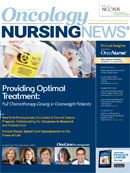Publication
Article
Oncology Nursing News
Today's Nurse Navigator: Educating and Advocating for Cancer Patients
Author(s):
As both patient advocate and educator, the ONN partners with physicians to help support the cancer patient's journey throughout the course of disease, with the ultimate goal of improving care and outcomes.
Sharon Francz, BHA
Executive Director, President, and Co-founder National Coalition of Oncology Nurse Navigators
The new standard from the American College of Surgeons Commission on Cancer (CoC) calling for the establishment of patient navigation programs in all CoC-accredited facilities by 2015 provides more evidence of the significant role the oncology nurse navigator (ONN) plays in the management of patients with cancer. As both patient advocate and educator, the ONN partners with physicians to help support the cancer patient’s journey throughout the course of disease, with the ultimate goal of improving care and outcomes.
Currently, 60% of ONNs are employed by a hospital or hospital system, and the balance work for oncology clinics or medical oncology practices. Although the greatest presence is in the community hospital setting, this trend is changing, as more oncology and radiation practices are adding navigation to their cancer programs.
In 2009, NCONN published the first competencies that defined the role of the ONN. Developed in consultation with active professional oncology nurse navigators throughout the United States, these core competencies cover five areas: 1) professional, legal and ethical nursing practice; 2) health promotion and health education; 3) management and leadership; 4) negotiating the healthcare delivery system and advocacy; and 5) personal effectiveness and professional development.
The Navigator’s Varied Role
ONNs mostly view themselves as clinical facilitators for oncology patients, with a primary focus on education. Their role in patient education is vast, encompassing disease-specific navigation, treatment options, processes, clarification on physician-provided information, directives, and what to expect overall on the patient’s journey.
Data collected by NCONN confirm this multifaceted role. Navigators consistently report education, explaining and clarifying diagnosis and treatment, coordinating care across multiple disciplines and providers, assisting with financial issues, psychosocial support, and initiating and completing treatment summary plans as their main duties. Navigators view themselves as patient advocates— making connections for the patient to other hospital/ medical professionals, getting answers, finding resources, and removing barriers, whether real or perceived.
A survey of approximately 1000 NCONN members asked ONN’s to identify the many tasks involved in a typical day in practice, which included new patient intake; patient education; outreach and community education; appointment scheduling; accompany patients to visits; patient phone or in person follow-ups; physician calls/discussions; arrange/ discuss transportation issues; assist/discuss/arrange financial issues; social work/counseling-related discussions; inhouse meetings, such as tumor board/cancer conferences.
The NCONN survey also asked respondents to name some of the biggest obstacles to a successful navigation program, and these included buy-in by physician and continued support of the navigation program; utilization of navigation services by physicians; management of time; tracking and documenting patient encounters; no resource support for secretarial-type tasks; inability or antiquated process for documenting encounters/time with patients; justifying role to hospital administrators/executives.
Measuring Outcomes
One of the primary goals of ONNs in practice today is to define and determine quality measures. Outcome measures answer the important question, “What is the return on the investment of having an oncology nurse navigator on board?” Some barriers that can prevent effective outcome measurement include staff resistance; lack of appropriate software for data collection; decreased time and resources required to collect, analyze, interpret, and report the data; lack of knowledge; and varied storage/ reporting mechanisms across the organization.1 Without robust outcomes measurement, ONNs are not able to demonstrate what they already know: Positive outcomes are related to navigators and navigation programs.
The role of the ONN continues to evolve. With the new CoC requirement, facilities looking to comply will need support and resources. NCONN, now more than 1000 members strong, has become a reliable resource and support for new navigators, new programs, and program expansion. To learn more, visit www.nconn.org.
Reference
1. Melnyk BM and Fineout-Overholt E, eds. Evidence-Based Practice in Nursing & Healthcare: A Guide to Best Practice. Philadelphia, PA: Lippincott, Williams & Wilkins; 2004.
Latest Conference Coverage

Zongertinib Elicits Durable Responses in Pretreated Advanced HER2-Mutant NSCLC

Lenvatinib Shows Efficacy in Advanced HCC Post-Progression on Atezolizumab/Bevacizumab

Sacituzumab Govitecan Does Not Significantly Improve OS in Pretreated Urothelial Carcinoma

Active Monitoring Is Noninferior to Guideline Concordant Care in Low-Risk DCIS
2 Commerce Drive
Cranbury, NJ 08512






